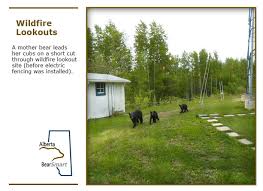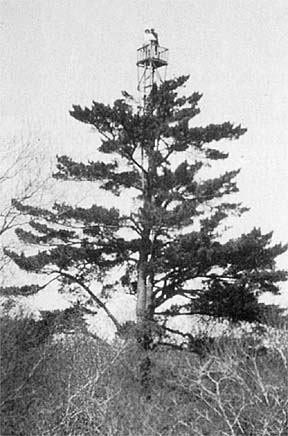ONTARIO’S FIRE WATCHTOWERS by BARNEY MOORHOUSE For Reproduction Rights Call Access 1.800.893.5777
During the late 1960s and early ‘70s I did a lot of canoe tripping throughout Ontario. Whenever I saw a fire tower I was obsessed to find and climb it. Somewhere, among boxes of film and slides, are loads of photos and the wonderful views. Somewhere!
Apparently, at one time, there were as many as 325 manned towers in Ontario, erected mostly between the 1920s and ‘50s. Apparently it took two weeks to erect a fire tower. While guiding a canoe trip for Y.M.C.A. Camp Pinecrest in the mid ‘60s we came upon the Go Home Lake tower on the NW side of the lake overlooking the channel which was still manned. Located in the Township of Georgian Bay, District of Muskoka, Go Home Lake was created in the 1950s by the construction of two dams. It was named after Go Home Bay, immediately downstream. Loggers would float their timber down the Musquash River to meet steamers at Go Home Bay. The steamers would transport the logs to the various mills around the Great lakes and then “go home.”

By then (the mid ‘60s) such towers were harder to find as air patrols, perhaps initiated by Frank MacDougall the first Flying Superintendent of Algonquin Park (1931-1941), had replaced them.
The campers were more than enthusiastic about climbing the tower and the tower man proved to be a patient informative story teller who apparently enjoyed our company. He demonstrated how he would report a sighted fire and recounted tales of his tower experiences.
Just as we were to exit he cautioned us about climbing down. “I had a lady up here once who told me she was very experienced in towers. In fact she had been up and down several in Europe. So I was rather surprised when she tried to descend by stepping into the hole as if she were walking down a flight of stairs. I had to grab her by the arm before she fell.” Or it would have been quite a frightful flight!
If you have never been in a tower you must first climb up to enter the little cabin, called a cupola, at the top, through a square hole in the floor. You exit by backing down, feet first, while grabbing onto the rungs of the ladder. While inside the cupola a trap door covers the exit.
I loved to climb the towers because I felt secure grabbing the ladder rungs. A circular support surrounding my body kept me from falling backwards. It was like climbing up a tunnel. I drew the line at the thought of climbing onto the roof of the cupola to repair the aerial. I didn’t even mind the tower’s movement as it constantly swayed back and forth. That did unnerve some.

One of the first fire towers in Ontario was built in Algonquin Park. At the top of a white pine. If you look at the photo you’ll see some people at the top on a rather small observation deck. One appears to be a woman. I can’t imagine building it let along being fit enough or adventurous enough to have climbed it. Especially in a dress. Or to be up there when a sudden lightning storm struck as happened to me while up the Maple Mountain tower in Temagami (once spelled Timagami) circa 1970.

For that outing we had put our canoes in at Mowat’s Landing and paddled and portaged four hours to our base camp on Lady Evelyn; a camp originally built by Col. McLaughlin of General Motors fame for friends and clients. The log cabins were built with vertical logs, as opposed to the more common horizontal logs with which you are probably more familiar. Apparently the builders had a Norwegian heritage.
From our base camp we had another day’s paddle and portage to the landing from where we could follow what I recall was a long uphill trail to the tower. The final part of the route involved climbing a ladder ascending the vertical face of a cliff. At the top was a small cabin where the tower man kept his supplies and radio. It must have been a challenge to radio in fire information as the tower man first had to descend the tower to make the call.
I recall standing full of excited anticipation in the swaying cupola watching a thunderstorm approach feeling that it was probably safer to stay inside the shelter then to risk a stormy exit with lightning flashing about. Little did I know that earlier towers of light steel that weren’t properly bolted had blown over. Or that the cupola on the Big Crow Lake fire tower, built in 1956, the last fire tower standing in Algonquin Park, would suffer a lightning strike and burn in 2010. That insight would have given me pause for thought, to reconsider my plight. I had also heard of the Bear Island Temagami tower that had reportedly been carried away by a tornado that roared through the area, never to be found. It looked like the Jolly Green Giant had cut a path through the forest with a lawn mower.
Working as a tower man was seasonal and it tended to attract writers and a variety of artists. A solitary existence, you needed to enjoy your own company. Tower men kept logbooks and guest books. A colleague found a diary at the Maple Mountain site, written by a semi-literate tower man. He probably would have fitted in well with to-day’s twittering, blogging and such with his phonetic spelling. Although, as one friend asked, “Don’t you find it unusual that phonetic starts with a ‘ph’?”
At the top of Maple Mountain, at the base of the tower, was an artesian well that supplied fresh water. There was an abundance of blueberries to boot. And, not to exaggerate, the blueberries could be the size of one’s thumbnail. They were huge and succulent.

The diary revealed that on one occasion the tower man was trapped in his tower for three days by black bears that had invaded his cabin and ate his food supplies for the week. Helplessly, he could only watch while on an enforced diet. Which segues me to Quetico Provincial Park where my wife and I celebrated our first anniversary during a 12 day canoe trip during the summer of 1972. Encountering a tower, naturally I had to climb it. My wife is not partial to heights and so declined. I suggested that she enjoy the blueberries at the base – but keep an eye out for bears. Which was sufficient motivation for her to climb. Halfway.
In 1970, one of our trips from Camp Kandalore (Canada-lore) canoed through Killarney Provincial Park, home of La Cloche Mountains, a.k.a. the La Cloche Range located along the northern shore of Lake Huron near Manitoulin Island. Mainly quartzite in content, they are estimated to be 3.5 billion years old; one of the oldest mountain ranges on earth. Perhaps at one time they were higher than the Rockies? According to one source they remain among the highest altitudes in Ontario. The French voyageurs named it La Cloche because when you strike some of the rocks they sound like a bell that can be heard for some distance.

The story goes that the Cloche tower was still manned and he delighted in telling the kids that in all of his years there he had never seen a fire. At which time one of the campers pointed out some distant smoke, raising the fire alarm. No sooner had they witnessed the tower man reporting the fire when another camper pointed out more smoke from another source. Two fires in one day!
Personally one of the most challenging climbs is the Dorset tower. It has a stairway that one ascends and descends meaning that, unlike climbing when you look up or straight ahead, you look down. That can have a dizzying effect.
Visitors to Algonquin Provincial Park can see a replicated fire tower at the Visitor Centre. The “Fire Tower Trail” is a new boardwalk that begins at the entrance. When I visited the centre in late October it had yet to be completed. Perhaps by the time this is published it will be open to visitors. Failing that, inside the centre is also a cupola depicting a towerman on duty. All part of a wonderful display featuring life in Algonquin Provincial Park. Perhaps readers might wish to plan a March Break trip to the centre. For more information regarding directions, hours of operation ….use your favourite search engine to help plan your outing.
